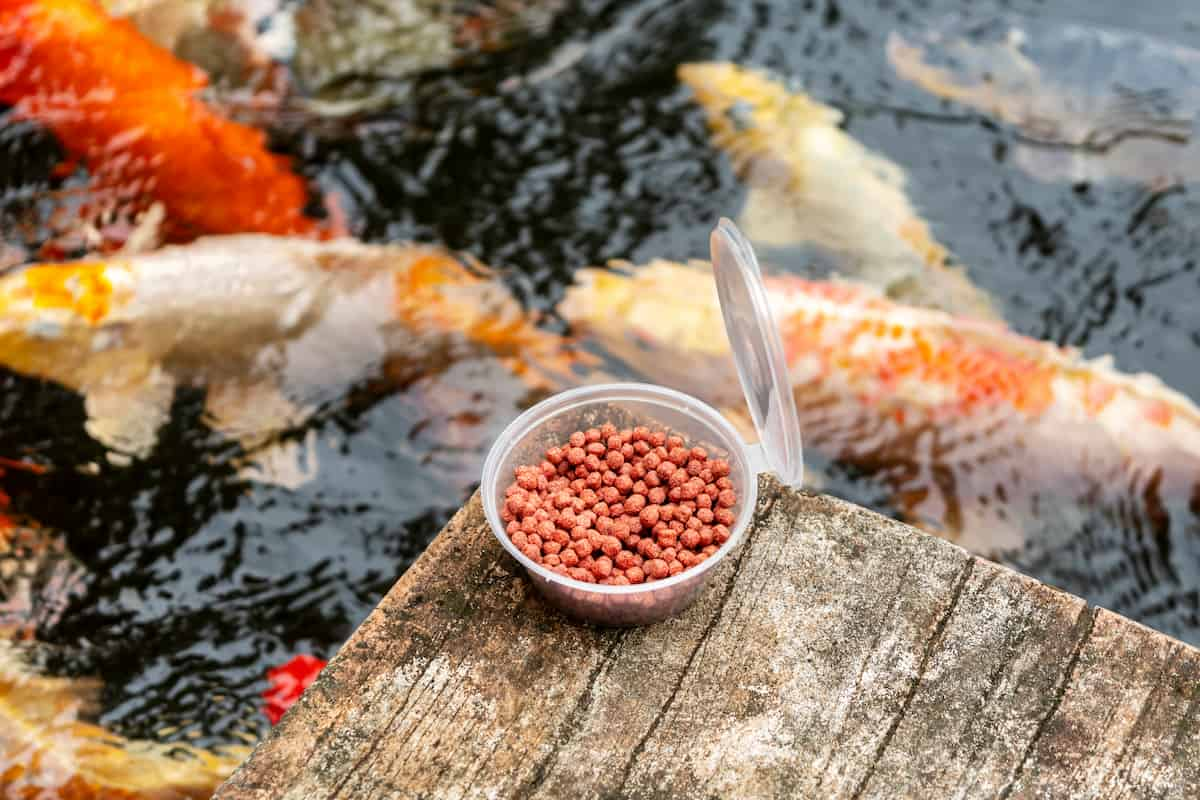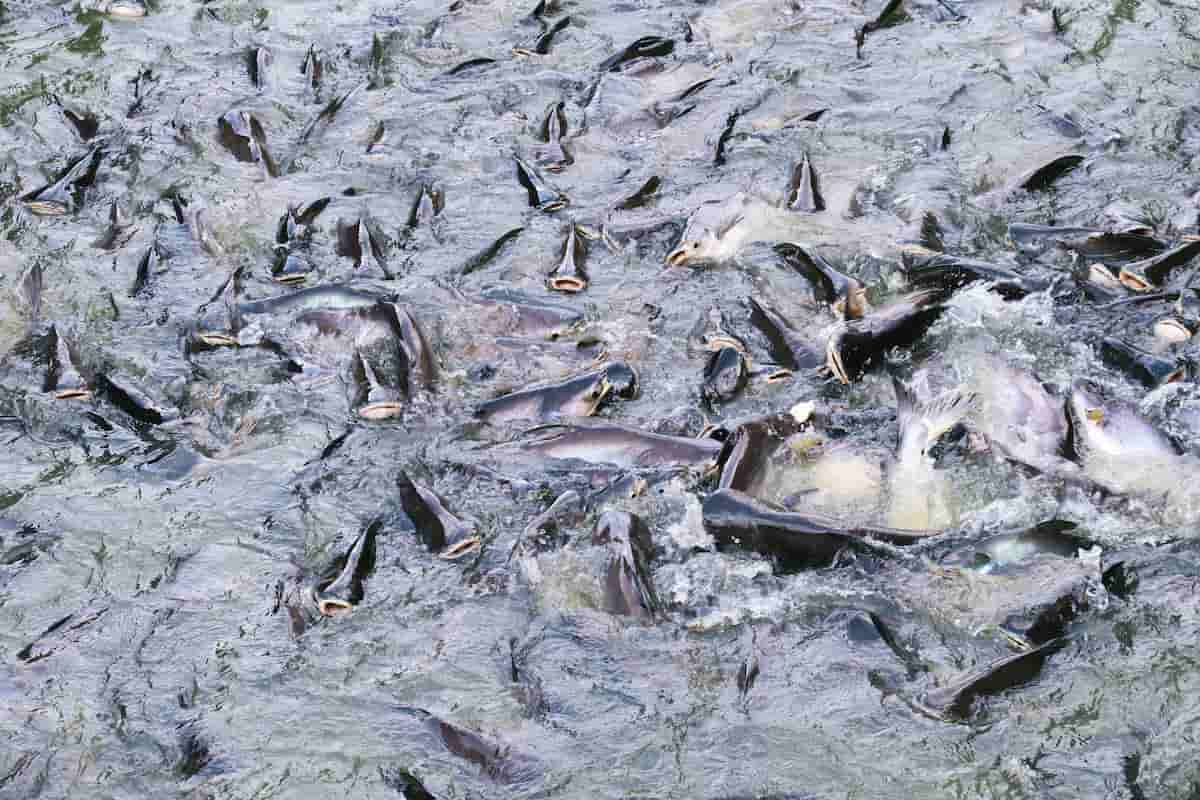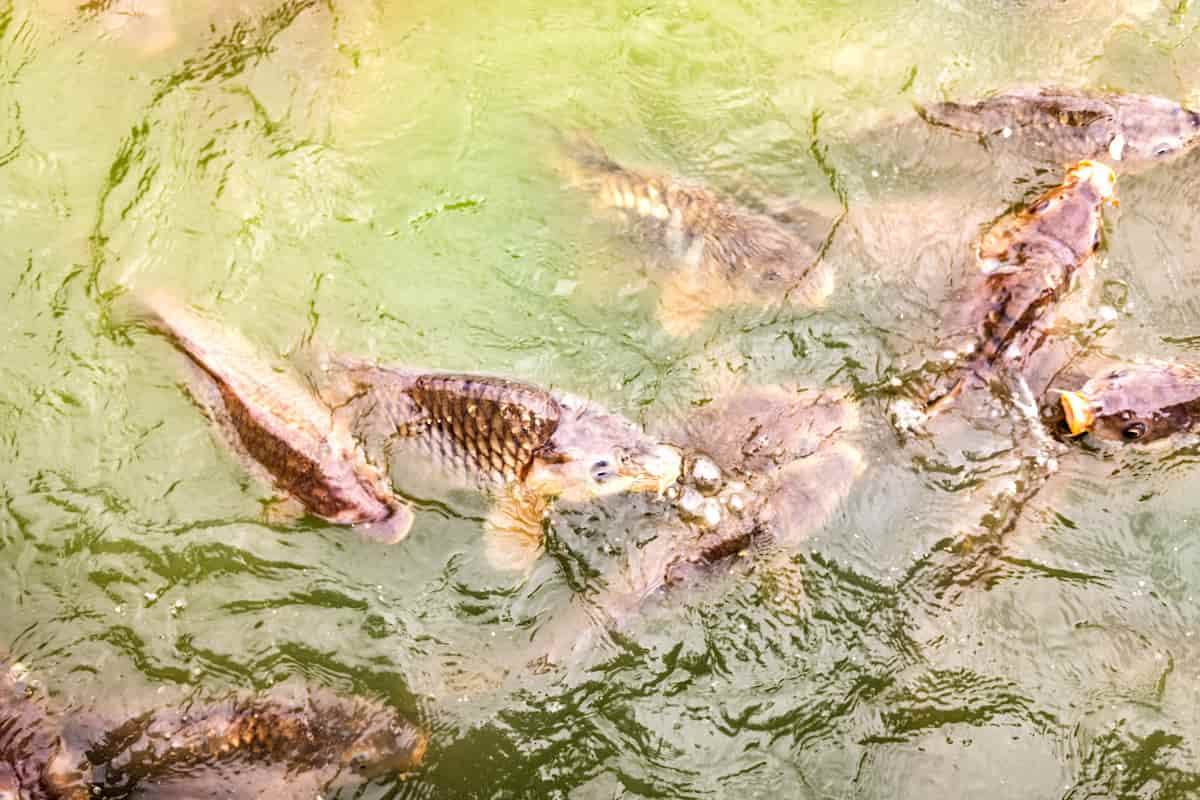One of the most important features of offish culture is that the fish should have good food. Feeding and fertilization together make the pond culture successful. Fish growth in the ponds is directly related to the food available. The pond must provide all the food and nutrients that the fish need. But all fishes do not need the same kind of food, for different species feed on different types of food; fish also feed on different foods depending on the stage of their life cycle.

Feed Management in Fish
Commercially Produced Feeds
Artificial or prepared feeds can be either complete or supplemental. Complete diets provide fish with all the ingredients they need for optimal growth and health (protein, carbohydrates, fats, vitamins, and minerals). The following components and percentage ranges are usually found in complete diets used by fish farmers:
- Protein: 18-50 percent
- Carbohydrate: 15-20 percent
- Lipids: 10-25 percent
- Ash: <8.5 percent
- Water: <10 percent;
- Phosphorus: <1.5 percent
- Trace amounts of vitamins and minerals
The feed’s nutritional content depends on what fish species are being raised and at what stage of their life cycle. If fish are kept in high-density indoor systems or cages where they cannot forage freely on natural food (e.g., algae, aquatic plants, aquatic invertebrates, etc.), they need a complete diet.
A supplemental diet, on the other hand, is intended only to supplement the natural food that fish normally find in ponds or outdoor raceways. Supplemental diets do not fully complement vitamins or minerals, but they provide protein, carbohydrates, and lipids to enhance the naturally available diet.
Fish Feed Types
A commercial fish diet can either be extruded (floating or buoyant) or pressure-pelleted (sinking). Although both floating and sinking feed can produce satisfactory growth, some fish prefer floating, while others prefer sinking. Shrimp, for example, will not accept floating feed, but most fish species can be trained to accept floating pellets. As a result of higher manufacturing costs, extruded feed is more expensive.
Typically, farmers prefer feeding floating (extruded) feeds because they can directly observe the feeding intensity of their fish and adjust the feeding rate accordingly. Maximizing fish growth and feed efficiency requires determining whether feeding rates are too low or too high. A variety of sizes of feed are available, from fine crumbles for small fish to large pellets (1/2-inch or larger). Pellets should be approximately 20-30 percent larger than the fish’s mouth gape.
Feeding too small a pellet requires more energy to find and eat more pellets, resulting in inefficient feeding. Conversely, large pellets will depress feeding and can, in the extreme, lead to choking. It would be best to choose a feed that is the largest size the fish will actively consume. The feed manufacturers usually provide a pellet size guide based on the species and life stage of the animal.
Feeding Rate, Frequency, and Timing
Feeding frequency and rates are partly influenced by fish size. Fry and larvae of small fish need high-protein diets frequently and often in excess. The energy requirements of small fish are high, so they must eat almost continuously and be fed almost hourly.
Because small fish require a small amount of feed relative to the volume of water in the culture system, overfeeding them is not as problematic as overfeeding larger fish. Feeding rates, frequency, and protein content should decrease as fish grow. Feeding low may allow the grower to use the same feed throughout the grow-out rather than switching to a lower-protein diet.
In case you missed it: How to Start Catla Fish Farming in 10 Steps: DIY Guide for Beginners

The process of feeding fish is labor-intensive and expensive. The frequency of feeding depends on the types and sizes of fish grown, the size of the farm, the production system, and the availability of labor. Because of time and labor constraints, large catfish farms with many ponds usually feed only once daily, while smaller farms may feed twice daily. Feeding frequency is generally associated with an increase in growth and feed conversion. For optimal growth in indoor, intensive fish culture systems, fish may be fed up to five times daily.
Fish feed at different rates depending on several factors. These factors include water temperature, dissolved oxygen levels, life stage, time of day, season, and other variables. For example, feeding fish grown in ponds early in the morning is not advisable when dissolved oxygen is at its lowest. In contrast, recirculating aquaculture systems where oxygen is continuously supplied allow fish to be fed at any time. The feeding rate of warm-water fish in ponds should decrease proportionally during the winter and when water temperatures are low.
| Cultured Fish | Feeding Habitat | Protein requirement | Fat Requirement | Suitable Fish Feed |
| Big Head carp | Feeding on Plankton | 18-23% | Under 5% | Water with high plankton content/peanut cake |
| Grass carp | Herbivorous | 18-23% | Under 5% | Grass/ low protein dry pellet feed |
| Scat | Omnivorous | 24-33% | 5-6% | Dry Pellet feed of medium protein content |
| Rabbit Fish | Omnivorous | 30% | 5% | Dry Pellet feed of medium protein content |
| Sea bass | Carnivorous | 38-42% | 6-10% | Dry/Moist pellet feed/ Trash fish |
| Grouper | Carnivorous | Above 45% | Above 10% | Dry/Moist pellet feed/ Trash fish |
| Seabream | Carnivorous | 40-45% | Under 5% | Dry/Moist pellet feed/ Trash fish |
| Whitefish Species | Carnivorous | 40-45% | 5-10% | Dry/Moist pellet feed/ Trash fish |
Medicated Fish Feeds
When fish stop feeding or reduce feeding, it is a signal to look for problems. Off-feed behavior is the first sign of trouble in the fish growing system, such as a disease or deteriorating water quality. The Food and Drug Administration approves very few therapeutic drugs for fish, but some medicated feeds are available for sick fish.
Medicated feeds are one of the easiest ways to treat fish, but they must be used early and quickly because sick fish frequently stop eating. Medicated feeds are strictly regulated and require a prescription from a veterinarian. It is important to dispose of leftover medicated feed properly.
Fish Feed Care and Storage
It is common for large farms to purchase commercial fish as bulk feed in truckloads and store them outside in bins. In smaller farms, prepared feed is often purchased in 50-pound bags. It is best to keep bagged feed out of direct sunlight and as cool as possible.
Proteins, vitamins, and lipids are particularly heat-sensitive and can be readily denatured by high storage temperatures. High moisture levels stimulate mold growth and feed decomposition. The feed bags should not be handled or damaged in any way that could break the pellets or create fines (powder) that the fish cannot consume.
In case you missed it: How to Start Carp Fish Farming in 10 Steps: DIY Guide for Beginners

A feed inventory should be conducted regularly, not exceeding 90 to 100 days. Overstacked bags will crush pellets in lower bags, producing excessive fines (dust). Bags should not be stacked more than ten high. Regularly inspecting feed for mold is recommended before feeding; older feed should be used first. Immediately discard any moldy feed. Keeping the feed storage area free from mice, rats, roaches, and other pests is important.
Conclusion
Proper feeding management should be practiced to further reduce the cost of feeds in the grow-out culture operation of any fish. It should be remembered that excess feeds pollute the rearing water easily and waste money. Most feed companies recommend a feeding regime based on the arbitrary weight of the fish on a given day of culture. More often than not, the recommended feeding is twice the amount of what the fish requires. So the amount of feed should be based on the gross weight of the fish to be fed.
- Feed Your Flock for Less: Top 10 Tips to Save on Chicken Feed
- Ultimate Guide to Ossabaw Island Hog: Breeding, Raising, Diet, and Care
- Hatching Answers: The Top 10 Reasons Your Chickens Aren’t Laying Eggs
- Eggs and Economics: Breaking Down the Cost of Raising Backyard Chickens
- Defend Your Greens: Proven Methods to Keep Iguanas Out of Your Garden
- Ultimate Guide to Cinnamon Queen Chicken: A Comprehensive Guide for Beginners
- Ultimate Guide to California Tan Chicken: Breeding, Raising, Diet, Egg-Production and Care
- Ultimate Guide to Marsh Daisy Chicken: Breeding, Raising, Diet, and Care
- 10 Types of Chicken Farming Businesses You Can Start for Profits